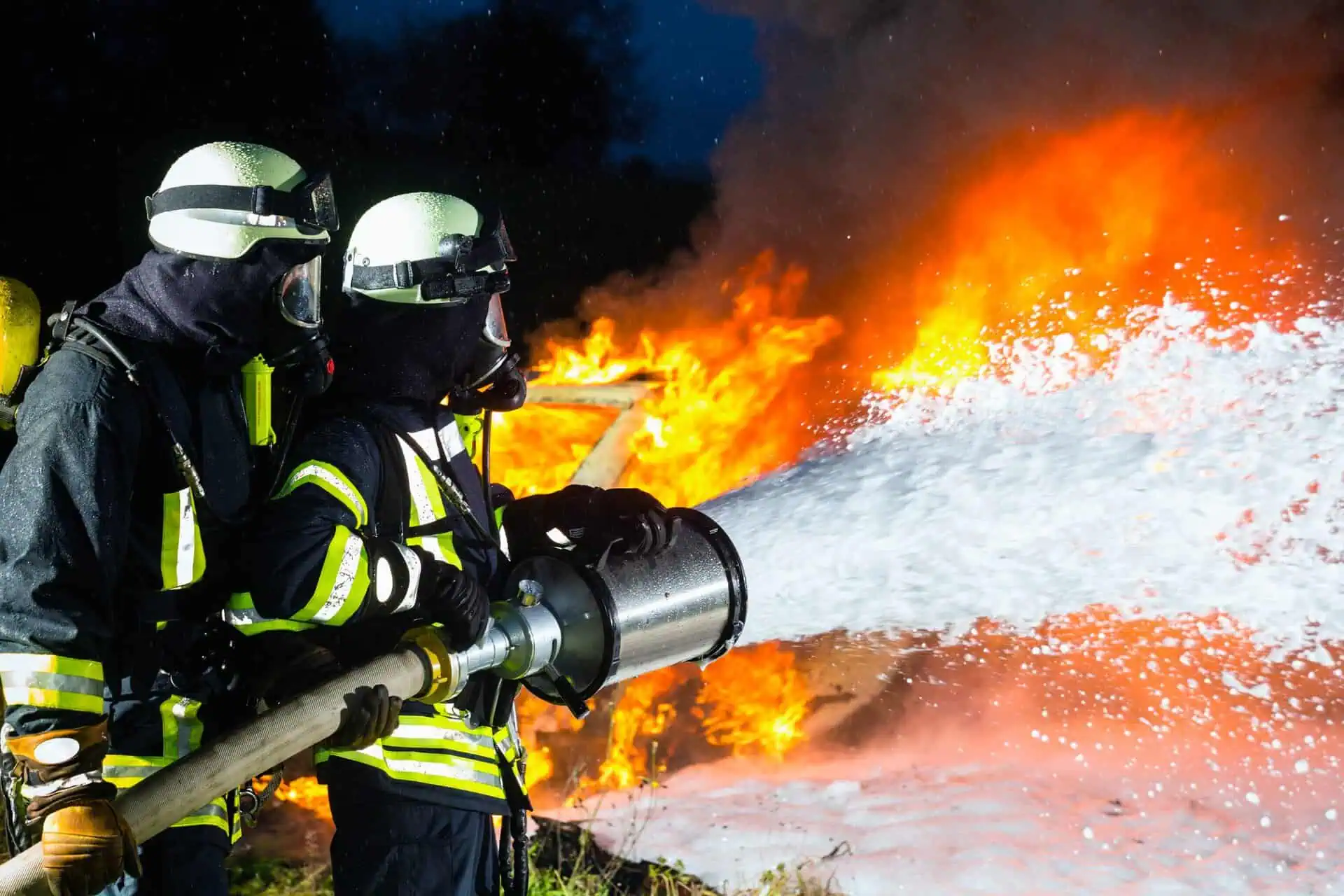AFFF Settlement: Firefighting Foam Cancer
- Last Updated: June 12th, 2025

Attorney Jessica Paluch-Hoerman, founder of TruLaw, has over 28 years of experience as a personal injury and mass tort attorney, and previously worked as an international tax attorney at Deloitte. Jessie collaborates with attorneys nationwide — enabling her to share reliable, up-to-date legal information with our readers.
Legally Reviewed
This article has been written and reviewed for legal accuracy and clarity by the team of writers and legal experts at TruLaw and is as accurate as possible. This content should not be taken as legal advice from an attorney. If you would like to learn more about our owner and experienced injury lawyer, Jessie Paluch, you can do so here.
Fact-Checked
TruLaw does everything possible to make sure the information in this article is up to date and accurate. If you need specific legal advice about your case, contact us by using the chat on the bottom of this page. This article should not be taken as advice from an attorney.
Key takeaways:
- The AFFF settlement addresses claims from exposure to toxic chemicals in firefighting foam, with eligibility criteria including proof of exposure and related health issues like cancer.
- Claimants may be entitled to compensation for medical expenses, lost wages, and pain and suffering, but must file within state-specific statutes of limitations to preserve their rights.
- Working with an experienced AFFF settlement attorney from TruLaw can help maximize compensation, build a compelling case, and provide skilled advocacy throughout the legal process.
Overview of the AFFF Settlement
On this page, we’ll discuss the AFFF Settlement process, what to expect during AFFF settlement negotiations, how to ensure a fair settlement for your AFFF lawsuit, and much more.
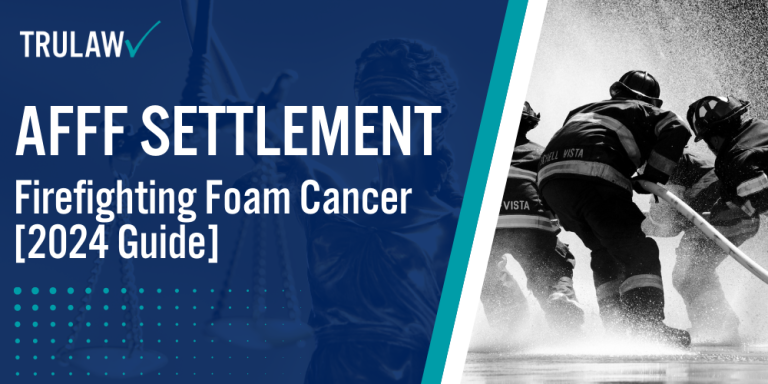
Intro to AFFF Settlement
The AFFF settlement process typically involves several key steps, including:
- Case Evaluation: An experienced attorney will review your case to determine your eligibility for an AFFF lawsuit and estimate your potential settlement amount.
- Evidence Gathering: Your lawyer will collect medical records, exposure evidence, and other documentation to support your claim.
- Negotiation: Your attorney will negotiate with the defendants’ legal team to reach a fair settlement agreement.
- Settlement Distribution: Once a settlement is reached, your lawyer will work to ensure that you receive your compensation in a timely manner.
If you have been harmed by exposure to AFFF, you may be entitled to significant compensation through an AFFF lawsuit settlement.
Contact TruLaw today by using the chat feature on this page for a free case evaluation to learn more about the settlement process and how to pursue the compensation you deserve.
Table of Contents
Cancer Risks Associated with PFAS Exposure
Exposure to PFAS chemicals, often referred to as forever chemicals, has been significantly associated with an increased risk of various types of cancer.
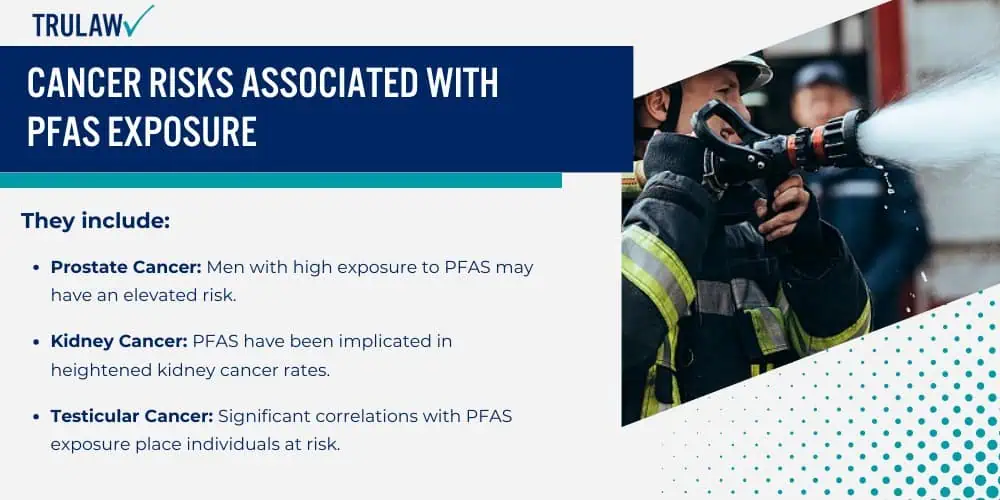
PFAS are a group of man-made toxic chemicals that have been widely used in products such as Aqueous Film Forming Foam (AFFF), which is used to fight fires.
Types of Cancer Linked to PFAS in AFFF
Studies indicate that PFAS exposure from AFFF is linked to several types of cancer.
They include:
- Prostate Cancer: Men with high exposure to PFAS may have an elevated risk.
- Kidney Cancer: PFAS have been implicated in heightened kidney cancer rates.
- Testicular Cancer: Significant correlations with PFAS exposure place individuals at risk.
- Bladder Cancer: There’s a noted concern for increased bladder cancer risk.
Other Potential Health Effects of PFAS Chemicals
Exposure to PFAS chemicals has been linked to a range of health issues beyond cancer.
These substances can disrupt various bodily functions and cause long-lasting effects.
In addition to cancer, PFAS exposure can lead to a variety of adverse health effects:
- Thyroid Disease: PFAS chemicals can disrupt thyroid function.
- Other Health Risks: They may include changes in cholesterol levels and increased risk of obesity.
- Developmental Effects: PFAS exposure can affect the growth, learning, and behavior of infants and older children.
- Immune System Effects: Some studies have shown PFAS impact on immune system health.
Avoiding exposure to PFAS chemicals is essential as they can persist in the environment and the human body for extended periods.
They can accumulate and stay in the human body for long periods, leading to persistent health risks.
Populations Most at Risk for AFFF-Related Illnesses
Certain groups of individuals are particularly vulnerable to illnesses linked to exposure to substances found in AFFF, including firefighters and residents of communities with contaminated water supplies.
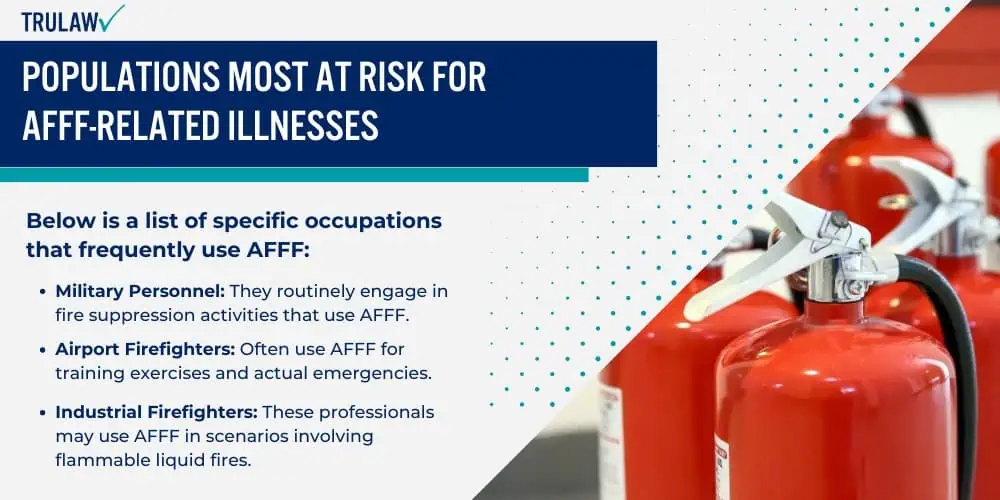
Occupations with Significant AFFF Exposure
Firefighters often come into contact with aqueous film-forming foam (AFFF) during firefighting operations.
Persistent exposure to AFFF may put them at an increased risk for health issues.
Below is a list of specific occupations that frequently use AFFF:
- Military Personnel: They routinely engage in fire suppression activities that use AFFF.
- Airport Firefighters: Often use AFFF for training exercises and actual emergencies.
- Industrial Firefighters: These professionals may use AFFF in scenarios involving flammable liquid fires.
- Chemical Plant Employees: Workers might encounter AFFF during emergency responses within the facility.
History of PFAS Use in Firefighting Foam
The Firefighter Cancer Registry Act was established in light of growing concerns about the high incidence of cancer among firefighters.
Studies suggest cancer risks are connected to PFAS in firefighting foam.
Here’s an overview of key developments regarding the use of PFAS in firefighting foam:
- PFAS chemicals have been integral in AFFF due to their strong fire-suppressing capabilities.
- Long-chain PFAS, once standard in AFFF, are believed to be more hazardous and persistent in the environment.
- Newer formulations include shorter-chain PFAS, which are thought to be less harmful but still pose potential risks.
- Regulations and guidelines are evolving to minimize the inclusion of harmful PFAS in firefighting products.
How PFAS Enter the Body and Accumulate
When discussing AFFF exposure, it’s crucial to understand how PFAS compounds are absorbed and accrued in living organisms.
Here are the various ways that PFAS compounds can enter the body and accumulate:
- Inhalation: Particles and vapours can be inhaled during firefighting or manufacturing with PFAS-containing AFFF firefighting foams.
- Ingestion: Drinking contaminated water or consuming food from affected areas can lead to intake.
- Dermal Contact: Direct skin contact with AFFF may contribute to absorption, though less significant.
- Chronic Exposure: Consistent and prolonged exposure increases the risk of PFAS accumulation in the body.
Eligibility Criteria for AFFF Settlement Claims
The eligibility criteria for AFFF settlement claims pertain directly to individuals or entities affected by AFFF-related incidents.
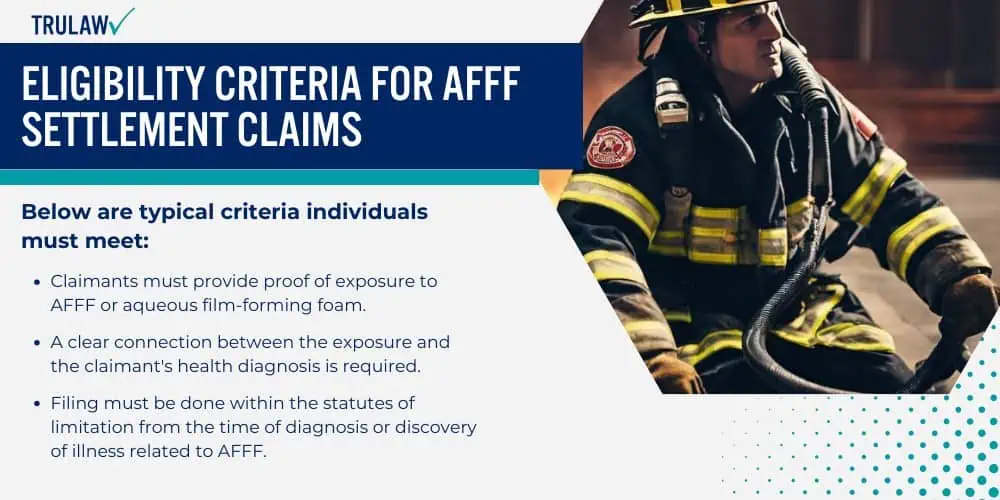
Claimants must meet specific requirements and understand the types of compensation offered.
Requirements to Qualify for the AFFF Settlement
Eligibility for the AFFF settlement is a critical first step for claimants pursuing justice.
Below are typical criteria individuals must meet:
- Claimants must provide proof of exposure to AFFF or aqueous film-forming foam.
- A clear connection between the exposure and the claimant’s health diagnosis is required.
- Filing must be done within the statutes of limitation from the time of diagnosis or discovery of illness related to AFFF.
- Claimants should not have received compensation for their personal injury claims from other settlements related to AFFF.
Types of Compensation Available to Claimants
Compensation is available to those who have validly established their claims.
Claimants may be entitled to different types of restitution, including:
- Medical expenses, both current and future, related to cancer diagnosis or other health issues caused by AFFF.
- Loss of wages or earning capacity stemming from the debilitating effects of AFFF exposure.
- Non-economic damages, such as pain and suffering or reduction in life quality.
In some cases, punitive damages may be awarded if it is proven that the entities manufacturing the toxic firefighting foam willfully neglected or acted in misconduct.
Deadlines and Time Limits for Filing AFFF Claims
When pursuing an AFFF firefighting foam lawsuit, understanding the time limits for filing a claim is essential.
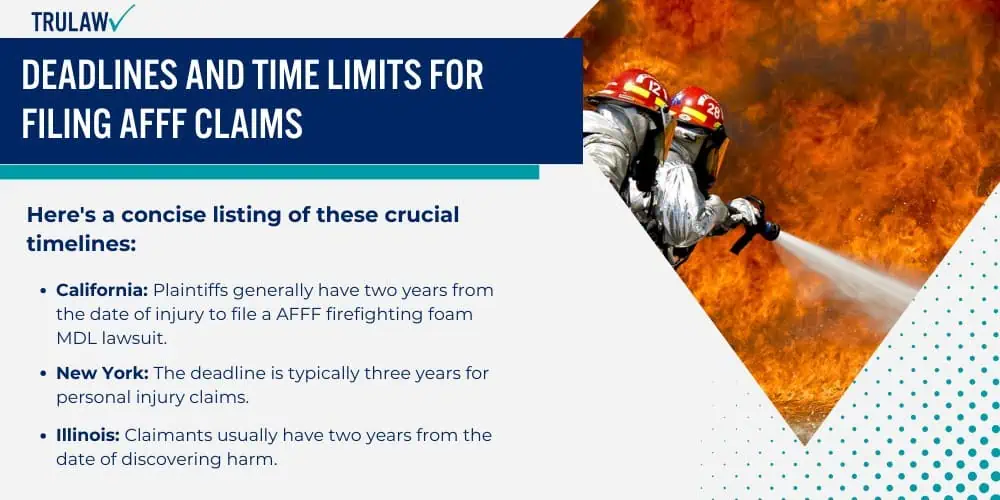
Each state has its own statutes of limitations, and failing to file within these deadlines can result in the loss of one’s right to seek compensation.
Statutes of Limitations on AFFF Lawsuits by State
States impose varying deadlines for initiating legal action in firefighting foam lawsuits.
Here’s a concise listing of these crucial timelines:
- California: Plaintiffs generally have two years from the date of injury to file a AFFF firefighting foam MDL lawsuit.
- New York: The deadline is typically three years for personal injury claims.
- Illinois: Claimants usually have two years from the date of discovering harm.
- Texas: The statute of limitations is generally two years from the injury date.
These periods can differ based on specific circumstances, so potential claimants should consult with a legal professional to determine applicable time frames.
Importance of Acting Quickly to Preserve Your Rights
Acting swiftly is essential for individuals seeking to file an AFFF lawsuit.
Here are some of the reasons for this urgency:
- Preserving Evidence: As time passes, crucial evidence may be lost or become harder to obtain.
- Witness Recollection: Witnesses’ memories may fade, affecting their ability to provide testimony.
- Legal Complexity: Federal court procedures, especially those in the District of South Carolina, can be intricate and require early preparation.
- Statutory Limitations: Missing a statute of limitations deadline can completely bar a claim.
Filing a timely legal claim, especially in wrongful death and AFFF personal injury cases, ensures the preservation of one’s legal rights and the ability to seek proper restitution in court.
Calculating the Average AFFF Settlement Amounts
When evaluating AFFF settlement cases, it is essential to understand the various factors that contribute to the calculation of average settlement amounts.
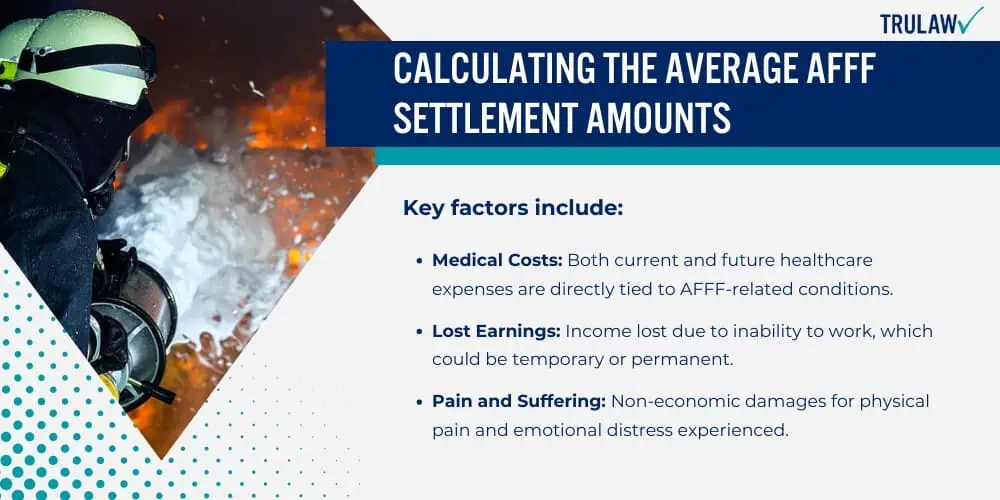
These include recoverable damages specified in the 2024 AFFF MDL and common injuries linked to AFFF exposure.
Recoverable Damages in the 2024 AFFF MDL
Compensation in AFFF firefighting foam cases reflects the extent of recoverable damages.
Key factors include:
- Medical Costs: Both current and future healthcare expenses are directly tied to AFFF-related conditions.
- Lost Earnings: Income lost due to inability to work, which could be temporary or permanent.
- Pain and Suffering: Non-economic damages for physical pain and emotional distress experienced.
- Punitive Damages: In certain cases, these may apply if the defendant’s conduct is proven to be particularly harmful.
Common Injuries Associated With AFFF Exposure
Aqueous Film-Forming Foam (AFFF) has been used for decades by firefighters and military personnel for its fire-suppressing capabilities.
However, growing concerns about the toxic chemicals in AFFF have sparked litigation due to their potential health risks.
AFFF exposure has been linked to specific health complications which inform the firefighting foam settlement negotiations:
- Cancer: Various types of cancer have been associated with AFFF, including kidney and testicular cancer.
- Thyroid Disease: Another health issue that plaintiffs have reported in relation to AFFF occupational exposure.
- Reproductive Issues: Some studies have suggested a correlation between AFFF and reproductive problems.
- Immune System Disorders: There’s evidence to suggest that AFFF exposure could lead to certain immune system disorders.
Settlement amounts in global settlement deals hinge upon the severity and type of injury suffered, as well as the individual’s exposure level.
These factors are critical in discussions of the firefighting foam settlement.
How an Experienced AFFF Settlement Attorney Can Help
Selecting the right legal representation can significantly impact the outcome of an AFFF settlement case.
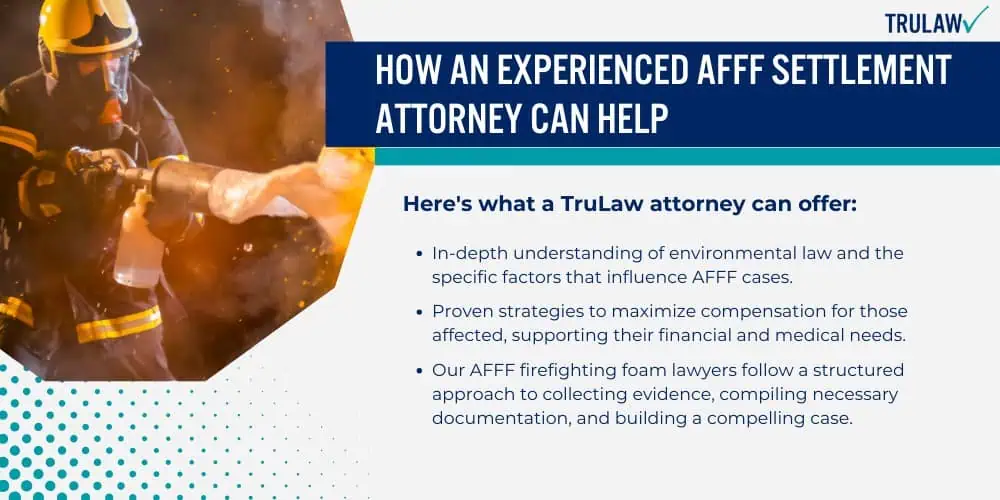
It ensures that the process is managed effectively and that the claimant’s rights are fully protected.
Benefits of Working with a TruLaw AFFF Lawyer
Our experienced firefighting foam lawyers bring many advantages to individuals seeking justice for exposure to harmful chemicals in firefighting foam.
Here’s what a TruLaw attorney can offer:
- In-depth understanding of environmental law and the specific factors that influence AFFF cases.
- Proven strategies to maximize compensation for those affected, supporting their financial and medical needs.
- Our AFFF firefighting foam lawyers follow a structured approach to collecting evidence, compiling necessary documentation, and building a compelling case.
- Persistent advocacy during settlement negotiations to secure a favorable outcome for clients.
Why Choose TruLaw for Your AFFF Cancer Claim
Choosing TruLaw for an AFFF cancer claim ensures that clients receive the expertise and guidance necessary for such sensitive cases.
They provide:
- Professional experience with a track record of success in similar lawsuits.
- A thorough understanding of the impact of firefighting foams on health and the ability to convey this effectively to a court.
- A commitment to personal attention, ensuring that each client is treated as an individual rather than just a case number.
- A dynamic legal team adept at tackling the unique challenges of AFFF litigation, ensuring clients are well-represented at every stage.
AFFF Lawsuit Frequently Asked Questions
-
Individuals who experienced exposure to AFFF and subsequently suffered from health issues associated with that exposure may be eligible to participate in the lawsuit.
Specific eligibility is determined on a case-by-case basis, taking into account factors such as the level and duration of exposure.
-
The compensation amount for AFFF lawsuit settlements can vary widely based on the individual circumstances of each case.
Factors influencing potential compensation include the severity of health impacts and the extent of exposure to AFFF contaminants.
-
The AFFF multidistrict litigation is in the discovery phase, with cases being prepared for trial.
It is an evolving process, with new developments and decisions affecting the progression of the AFFF cancer lawsuits.
So far, most of this class action’s attention has focused on municipal water contamination cases.
-
Claims in military lawsuits often stem from exposure to AFFF used in firefighting and training exercises.
These claims relate to the health risks associated with PFAS chemicals, which are a key component of traditional AFFF formulations.
-
Recent developments in the AFFF lawsuit against 3M include the announcement of a landmark settlement.
The company resolved claims related to its production and use of AFFF, which led to environmental contamination and associated health risks.
-
Eligible individuals should consult with legal counsel to determine the specific deadlines applicable to their case.
Timing can be critical in these firefighting foam cancer lawsuits, and missing a deadline may bar an individual from seeking compensation.

Managing Attorney & Owner
With over 25 years of legal experience, Jessica Paluch-Hoerman is an Illinois lawyer, a CPA, and a mother of three. She spent the first decade of her career working as an international tax attorney at Deloitte.
In 2009, Jessie co-founded her own law firm with her husband – which has scaled to over 30 employees since its conception.
In 2016, Jessie founded TruLaw, which allows her to collaborate with attorneys and legal experts across the United States on a daily basis. This hypervaluable network of experts is what enables her to share the most reliable, accurate, and up-to-date legal information with our readers!
Additional AFFF Lawsuit resources on our website:
Here, at TruLaw, we’re committed to helping victims get the justice they deserve.
Alongside our partner law firms, we have successfully collected over $3 Billion in verdicts and settlements on behalf of injured individuals.
Would you like our help?
At TruLaw, we fiercely combat corporations that endanger individuals’ well-being. If you’ve suffered injuries and believe these well-funded entities should be held accountable, we’re here for you.
With TruLaw, you gain access to successful and seasoned lawyers who maximize your chances of success. Our lawyers invest in you—they do not receive a dime until your lawsuit reaches a successful resolution!
AFFF Lawsuit claims are being filed against manufacturers of aqueous film-forming foam (AFFF), commonly used in firefighting.
Claims allege that companies such as 3M, DuPont, and Tyco Fire Products failed to adequately warn users about the potential dangers of AFFF exposure — including increased risks of various cancers and diseases.
Depo Provera Lawsuit claims are being filed by individuals who allege they developed meningioma (a type of brain tumor) after receiving Depo-Provera birth control injections.
A 2024 study found that women using Depo-Provera for at least 1 year are five times more likely to develop meningioma brain tumors compared to those not using the drug.
Suboxone Tooth Decay Lawsuit claims are being filed against Indivior, the manufacturer of Suboxone, a medication used to treat opioid addiction.
Claims allege that Indivior failed to adequately warn users about the potential dangers of severe tooth decay and dental injuries associated with Suboxone’s sublingual film version.
Social Media Harm Lawsuits are being filed against social media companies for allegedly causing mental health issues in children and teens.
Claims allege that companies like Meta, Google, ByteDance, and Snap designed addictive platforms that led to anxiety, depression, and other mental health issues without adequately warning users or parents.
Transvaginal Mesh Lawsuits are being filed against manufacturers of transvaginal mesh products used to treat pelvic organ prolapse (POP) and stress urinary incontinence (SUI).
Claims allege that companies like Ethicon, C.R. Bard, and Boston Scientific failed to adequately warn about potential dangers — including erosion, pain, and infection.
Bair Hugger Warming Blanket Lawsuits involve claims against 3M — alleging their surgical warming blankets caused severe infections and complications (particularly in hip and knee replacement surgeries).
Plaintiffs claim 3M failed to warn about potential risks — despite knowing about increased risk of deep joint infections since 2011.
Baby Formula NEC Lawsuit claims are being filed against manufacturers of cow’s milk-based baby formula products.
Claims allege that companies like Abbott Laboratories (Similac) and Mead Johnson & Company (Enfamil) failed to warn about the increased risk of necrotizing enterocolitis (NEC) in premature infants.
Here, at TruLaw, we’re committed to helping victims get the justice they deserve.
Alongside our partner law firms, we have successfully collected over $3 Billion in verdicts and settlements on behalf of injured individuals.
Would you like our help?
